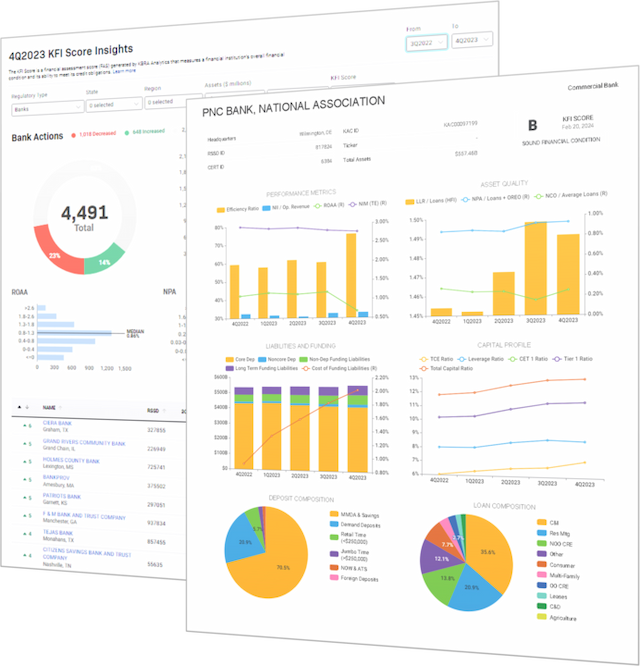KBRA Financial Intelligence
Small Credit Unions Decline, Higher for Longer, M&A Deals
By KFI Staff
Membership at Smallest Credit Unions Decline
The smallest credit unions (CUs), those with less than $100 million in assets, are struggling to retain members.
Membership at smaller CUs, which represent about 62% of all federally insured CUs, declined at a 1.1% compound annual growth rate (CAGR) in the last five years, according to a KBRA Financial Intelligence (KFI) analysis of National Credit Union Administration (NCUA) data. However, the largest CUs, those above $1 billion in assets, are driving industry growth, with the number of members climbing 4.6% in the same period.
CUs, which are owned by members, have also increased assets at almost twice the pace of banks over the past 10 years to $2.2 trillion. The largest lenders increased total shares and deposits at a 10.3% CAGR since 2018, according to KFI’s analysis. However, the smallest CUs fell behind, growing 4.4% in the same period.
Smaller CUs are lagging in part because they have struggled to keep up with the technology and services that consumers now expect from a financial provider. As a result, many smaller CUs are consolidating or being acquired. This has contributed to the decline in the number of overall CUs, which have dropped about 28% to 4,686 from more than 6,500 at the end of 2013, according to NCUA annual reports.
“Consolidation is going to continue unabated,” said Jim Adkins, co-founder and managing partner of Artisan Advisors, a consulting firm for community banks and CUs. “You just need such economies of scale to be successful.”
Merrimack Valley CU (KFI Score: B+) doubled its total assets to $2.3 billion after pursuing multiple acquisitions, including one with RTN Federal Credit Union that closed in June. See the full analysis here:
ANALYZE BANK METRICS WITH KFI PRO
KFI offers a new alternative for bank peer analysis with regulatory data sets for all U.S. banks and GAAP financials for public companies.
Bankers can leverage tools and templates to better manage quarterly reporting processes for board meetings, Reg F, and ALCO.
KFI’s Screener feature ranks lenders across financial ratios from net interest margin to ROAE to delinquent loans. Results are easily exported into Excel.
Subscribers leverage our KFI Scores, which measure the financial health of all U.S. banks and credit unions on an A to E scaling using our proprietary quantitative model.
Community Banks Grapple with Higher for Longer
Community banks are adapting to a more hawkish Federal Reserve after the central bank raised rates 11 times since spring 2022. The rapid rise in Treasury rates is tightening financial conditions, with the 10-year yield briefly surpassing 5% for the first time since 2007.
“The two big words are ‘higher, longer,’” said Greyson Tuck, president of legal and consulting firm Gerrish Smith Tuck. In the current environment, banks are less focused on big-picture opportunities and more on managing their current book of business. Smaller banks are saying, “We’re going to hold our nose in 2024.”
Smaller banks are making less money in 2023 amid the fastest increase in interest rates in a generation. The view that the Fed would be cutting rates this year—a forecast held in the wake of the bank failures this spring—has been thrown out. Interest rate traders are anticipating the Fed will hold rates steady in its November 1 meeting, according to the CME FedWatch Tool, which forecasts rate moves based on trading data.
ICYMI
KFI recently examined the growth in credit card debt, which has surpassed $1 trillion, and tracked the decline in bank deposits, the first year-over-year decline in records going back to 1994.
Q3 2023 Data Next week, look out for our Q3 Snapshot report, where we’ll analyze performance metrics such as nonperforming assets and net interest margins across the largest, smallest, and community banks.
Recent M&A Guaranty Capital Corp., the holding company for Guaranty Bank & Trust Company (KFI Score: B-), agreed on October 17 to buy fellow Mississippi lender Lafayette Bancorp and its Oxford University Bank (B+). The combined banks will have about $2.6 billion in assets with 39 branches across Mississippi and Tennessee. The deal is expected to close in Q1 2024.
Central Valley Community Bank (B) and its holding company agreed on October 10 to acquire Community West Bank (B) and its parentin an all-stock transaction valued at $99.4 million. The deal with the two California lenders, which is expected to close in Q2 2024, will create a $3.6 billion bank. The takeover will be the sixth acquisition for Central Valley since 2005.
3 Things in Credit
Follow KBRA’s Chief Strategist, Van Hesser, and his 3 Things in Credit podcast. From the October 20 episode:
“We keep bringing this up to counter those in the camp of no or even soft landing and immaculate disinflation. Let’s put it this way: If the tightening of credit is not slowing economic growth, and by extension inflation, then the Fed will tighten credit further. Maybe not through additional rate hikes, but by leaving high rates in place for longer, and by leaving QT in place. Either way, the Fed is going to win this battle.”
